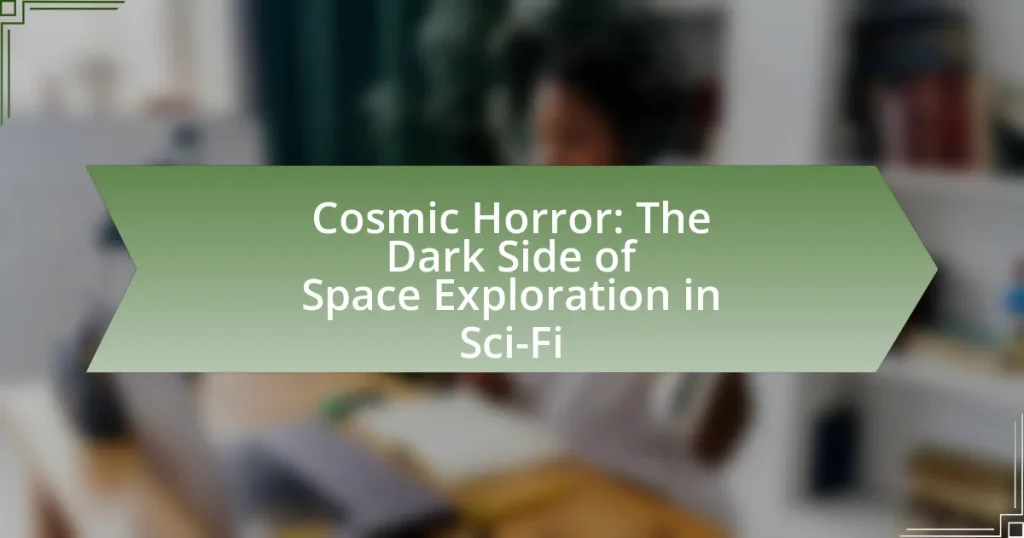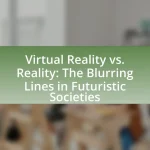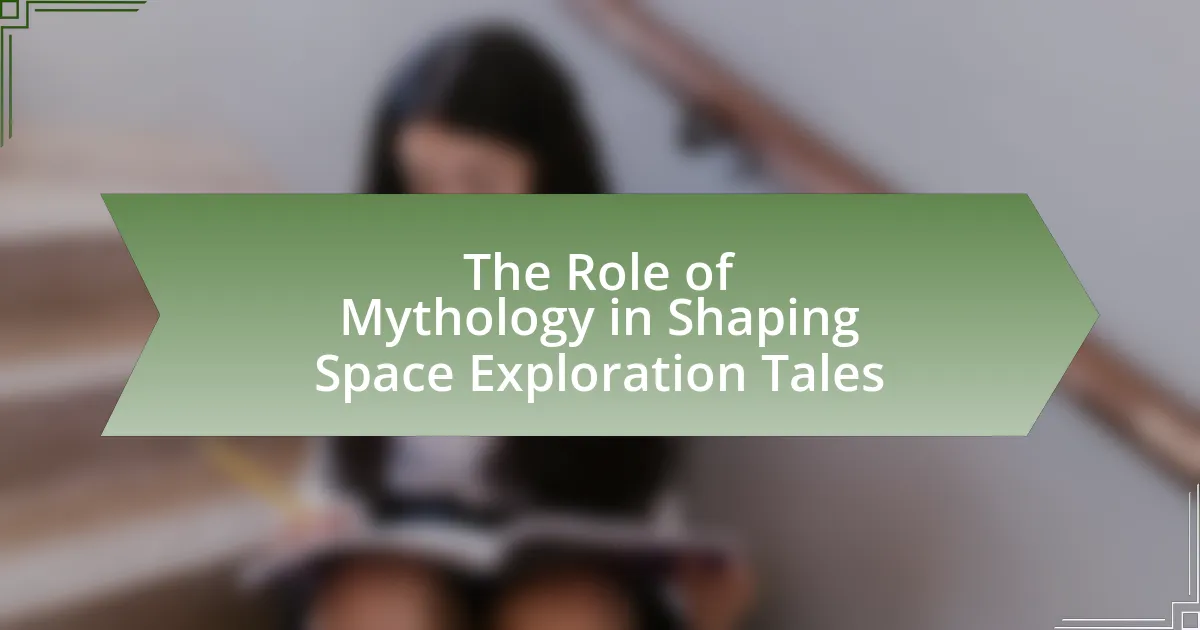Cosmic horror is a subgenre of horror that highlights humanity’s insignificance in the vast universe and the existential dread stemming from encounters with incomprehensible cosmic entities. This article explores the characteristics of cosmic horror within the context of space exploration, differentiating it from other horror genres by its focus on existential themes and the unknown. Key themes include the fragility of human existence, the portrayal of ancient, powerful beings, and the psychological effects of confronting the vastness of space. Notable works and authors, particularly H.P. Lovecraft, are examined, alongside the impact of cosmic horror on contemporary literature and media, illustrating how these narratives resonate with societal fears surrounding space exploration.
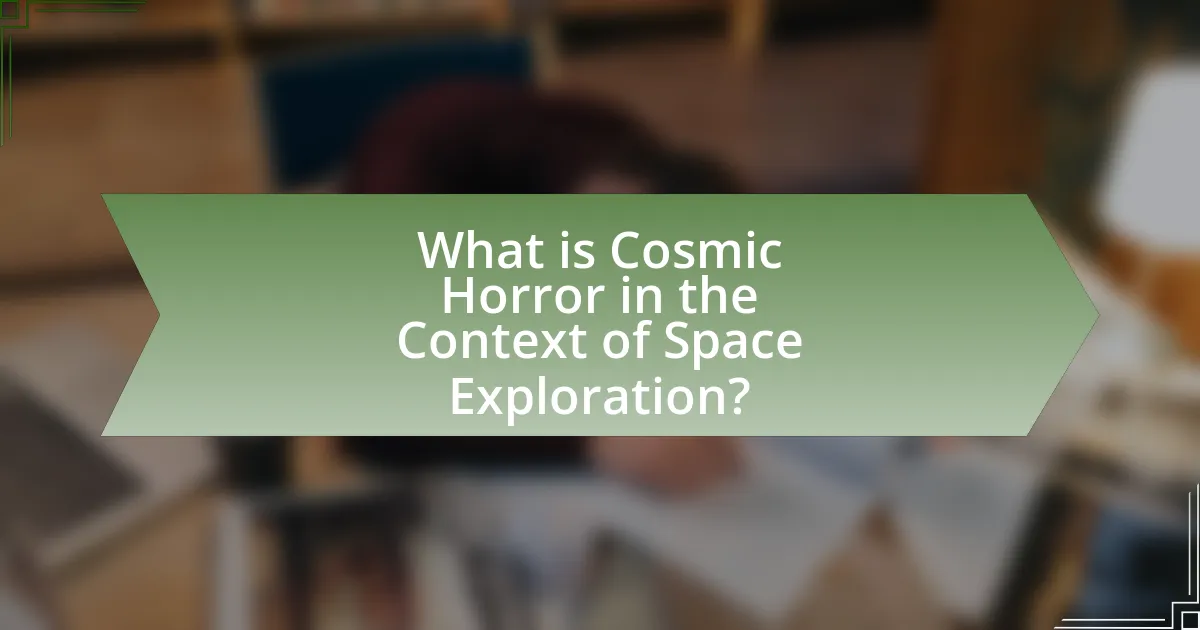
What is Cosmic Horror in the Context of Space Exploration?
Cosmic horror in the context of space exploration refers to a subgenre of horror that emphasizes the insignificance of humanity in the vastness of the universe and the existential dread that arises from encountering incomprehensible cosmic entities or phenomena. This genre often portrays space as a realm filled with ancient, malevolent forces that challenge human understanding and provoke fear of the unknown. Notable examples include H.P. Lovecraft’s works, where characters confront alien beings and the realization that humanity is a mere speck in an indifferent cosmos, illustrating the psychological terror associated with the vastness and mystery of space.
How does Cosmic Horror differ from other horror genres?
Cosmic Horror differs from other horror genres primarily in its focus on the insignificance of humanity in the face of incomprehensible cosmic entities and the vastness of the universe. Unlike traditional horror, which often centers on personal fears, monsters, or psychological terror, Cosmic Horror emphasizes existential dread and the unknown, suggesting that the universe is filled with ancient, powerful beings indifferent to human existence. This genre is exemplified by the works of H.P. Lovecraft, who portrayed a universe where human understanding is limited and often leads to madness when confronted with the true nature of reality.
What themes are prevalent in Cosmic Horror narratives?
Cosmic Horror narratives predominantly explore themes of existential dread, the insignificance of humanity, and the incomprehensibility of the universe. Existential dread manifests through characters confronting the vastness of space and the realization that human existence is trivial in the grand scheme of cosmic forces. The insignificance of humanity is illustrated by the presence of ancient, powerful entities that exist beyond human understanding, often leading to madness or despair. The incomprehensibility of the universe is emphasized through the depiction of alien beings and phenomena that defy human logic and perception, reinforcing the idea that there are realities beyond human grasp. These themes are exemplified in works by H.P. Lovecraft, where protagonists often encounter the unknown and face the terrifying implications of their discoveries.
How does the vastness of space contribute to feelings of dread?
The vastness of space contributes to feelings of dread by evoking a sense of insignificance and isolation in individuals. This immense scale can lead to existential anxiety, as the sheer emptiness and unknown elements of the universe highlight humanity’s vulnerability. Research indicates that the concept of cosmic horror, as explored in literature and film, often stems from the realization that the universe is indifferent to human existence, amplifying fears of the unknown and the uncontrollable. For instance, H.P. Lovecraft’s works illustrate how the vastness of space can provoke terror by suggesting that there are incomprehensible forces beyond human understanding, reinforcing the idea that humanity is merely a small, fragile part of a much larger, uncaring cosmos.
Why is Cosmic Horror significant in science fiction?
Cosmic Horror is significant in science fiction because it explores the insignificance of humanity in the vast universe, often highlighting existential dread and the unknown. This genre, popularized by authors like H.P. Lovecraft, emphasizes themes of incomprehensible cosmic entities and the fragility of human sanity when confronted with the universe’s vastness. The significance is underscored by its ability to provoke deep philosophical questions about existence, knowledge, and the limits of human understanding, as seen in works like “The Call of Cthulhu,” where characters face the terrifying realization of their own powerlessness.
What role does the unknown play in Cosmic Horror stories?
The unknown serves as a central element in Cosmic Horror stories, driving the narrative and evoking existential dread. This genre emphasizes the insignificance of humanity in the face of incomprehensible cosmic forces and entities, often leaving characters confronted with mysteries beyond their understanding. For instance, H.P. Lovecraft’s works illustrate how the unknown leads to madness and despair, as characters encounter ancient beings and truths that challenge their perception of reality. The fear of the unknown in these stories highlights humanity’s vulnerability and the limits of knowledge, reinforcing the theme that some truths are better left undiscovered.
How do Cosmic Horror elements reflect societal fears about space exploration?
Cosmic Horror elements reflect societal fears about space exploration by emphasizing the insignificance of humanity in the vast universe and the potential for encountering incomprehensible entities. This genre often portrays space as a realm filled with ancient, malevolent forces that challenge human understanding and morality, highlighting anxieties about the unknown and uncontrollable aspects of the cosmos. For instance, H.P. Lovecraft’s works illustrate how the discovery of extraterrestrial life could lead to existential dread, as seen in “The Call of Cthulhu,” where humanity’s fragility is starkly contrasted against the backdrop of cosmic indifference. Such narratives resonate with contemporary fears surrounding space exploration, including the risks of technological overreach and the ethical implications of contacting alien civilizations.
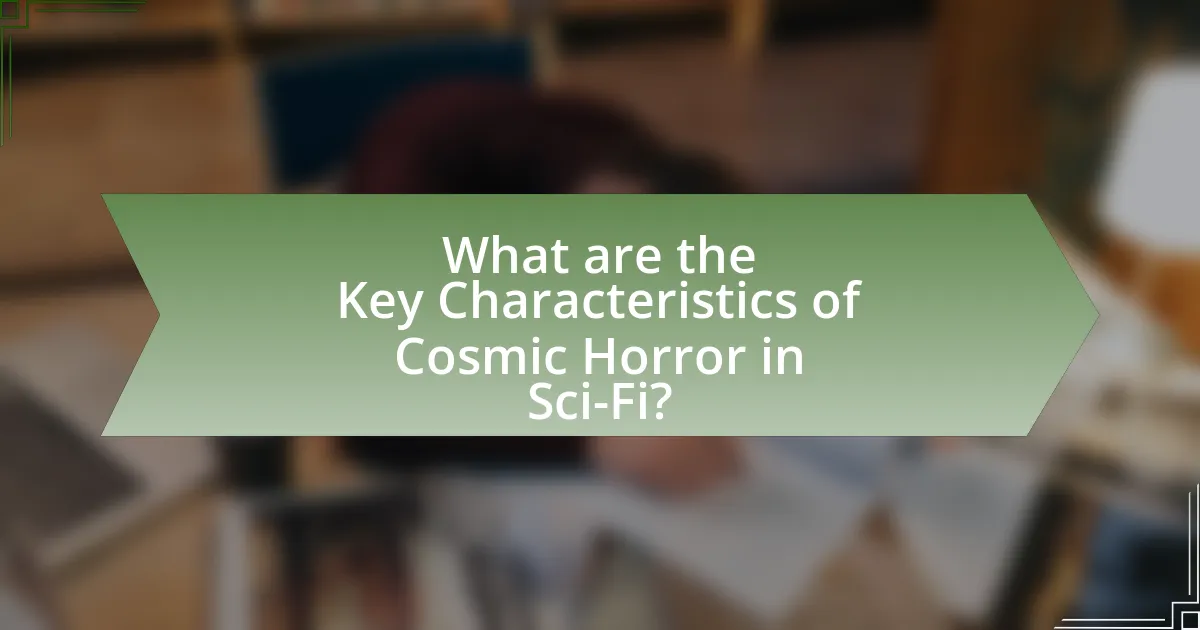
What are the Key Characteristics of Cosmic Horror in Sci-Fi?
The key characteristics of cosmic horror in sci-fi include the insignificance of humanity, the presence of incomprehensible entities, and the exploration of existential dread. Cosmic horror emphasizes that humans are a minuscule part of an indifferent universe, often confronting beings or forces that are beyond human understanding, such as ancient aliens or cosmic deities. This genre evokes a profound sense of fear and anxiety stemming from the realization that the universe is vast and uncaring, as seen in works like H.P. Lovecraft’s “The Call of Cthulhu,” where characters encounter entities that challenge their sanity and perception of reality. The narrative often highlights themes of isolation and the fragility of human existence in the face of cosmic forces, reinforcing the idea that knowledge can lead to despair rather than enlightenment.
What types of entities are commonly featured in Cosmic Horror?
Cosmic Horror commonly features entities such as ancient, god-like beings, extraterrestrial creatures, and incomprehensible entities that defy human understanding. These entities often embody themes of existential dread and the insignificance of humanity in the vast universe. For instance, H.P. Lovecraft’s Cthulhu is a prime example of an ancient being that represents humanity’s vulnerability to forces beyond its comprehension. Additionally, works in this genre frequently depict alien species that possess advanced technology or knowledge, further emphasizing the theme of humanity’s limited perspective in the cosmos.
How do these entities challenge human understanding?
Entities in cosmic horror challenge human understanding by presenting incomprehensible forms of existence and intelligence that defy the laws of nature as we know them. These entities, often depicted as ancient and powerful beings, evoke a sense of insignificance in humanity, highlighting the limitations of human perception and knowledge. For example, H.P. Lovecraft’s Cthulhu represents an entity whose very existence undermines the foundations of reality, suggesting that there are dimensions and truths beyond human grasp. This portrayal forces individuals to confront the unsettling idea that the universe may be filled with forces that are indifferent or hostile to human life, thereby expanding the boundaries of existential dread and philosophical inquiry.
What psychological effects do these entities have on characters?
Entities in cosmic horror often induce profound psychological effects on characters, primarily manifesting as existential dread, paranoia, and madness. These effects stem from the characters’ encounters with incomprehensible beings or forces that challenge their understanding of reality. For instance, in H.P. Lovecraft’s works, characters frequently experience a breakdown of their sanity when confronted with the vastness of the cosmos and the insignificance of humanity, leading to a sense of hopelessness and despair. This psychological turmoil is supported by the idea that exposure to the unknown can trigger deep-seated fears and anxieties, as evidenced by studies in psychology that link existential threats to increased levels of anxiety and depressive symptoms. Thus, the psychological effects of these entities are characterized by a destabilization of the mind, resulting in a loss of identity and a pervasive sense of fear.
How is the theme of insignificance portrayed in Cosmic Horror?
The theme of insignificance in Cosmic Horror is portrayed through the depiction of humanity’s vulnerability in the face of incomprehensible cosmic entities. These narratives often illustrate that human existence is trivial compared to the vastness of the universe and the ancient, powerful beings that inhabit it. For example, in H.P. Lovecraft’s works, such as “The Call of Cthulhu,” the insignificance of humanity is emphasized by the existence of cosmic beings whose motives and powers are beyond human understanding, leading to existential dread. This portrayal serves to highlight the fragility of human life and the futility of human endeavors against the backdrop of an indifferent universe.
What literary techniques emphasize human insignificance in the universe?
Literary techniques that emphasize human insignificance in the universe include cosmic irony, existential themes, and the use of vast, indifferent settings. Cosmic irony highlights the contrast between human aspirations and the universe’s indifference, often showcasing characters’ futile struggles against incomprehensible forces. Existential themes explore the meaninglessness of human existence in the face of an uncaring cosmos, as seen in works like H.P. Lovecraft’s stories, where characters confront their own insignificance. Additionally, vast and indifferent settings, such as the infinite expanse of space, serve to illustrate the smallness of humanity, reinforcing the idea that human life is trivial in the grand scheme of the universe. These techniques collectively create a sense of dread and highlight the limitations of human understanding in a vast, uncaring universe.
How do characters react to their perceived insignificance?
Characters in cosmic horror often react to their perceived insignificance with existential dread, despair, or madness. This reaction stems from the realization that they are mere specks in an incomprehensibly vast universe, leading to feelings of helplessness and vulnerability. For instance, in H.P. Lovecraft’s works, characters frequently confront ancient, powerful entities that render human concerns trivial, resulting in psychological breakdowns or a complete loss of sanity. This theme illustrates how the vastness of space and the insignificance of humanity can provoke profound emotional and mental turmoil, reinforcing the core tenets of cosmic horror.
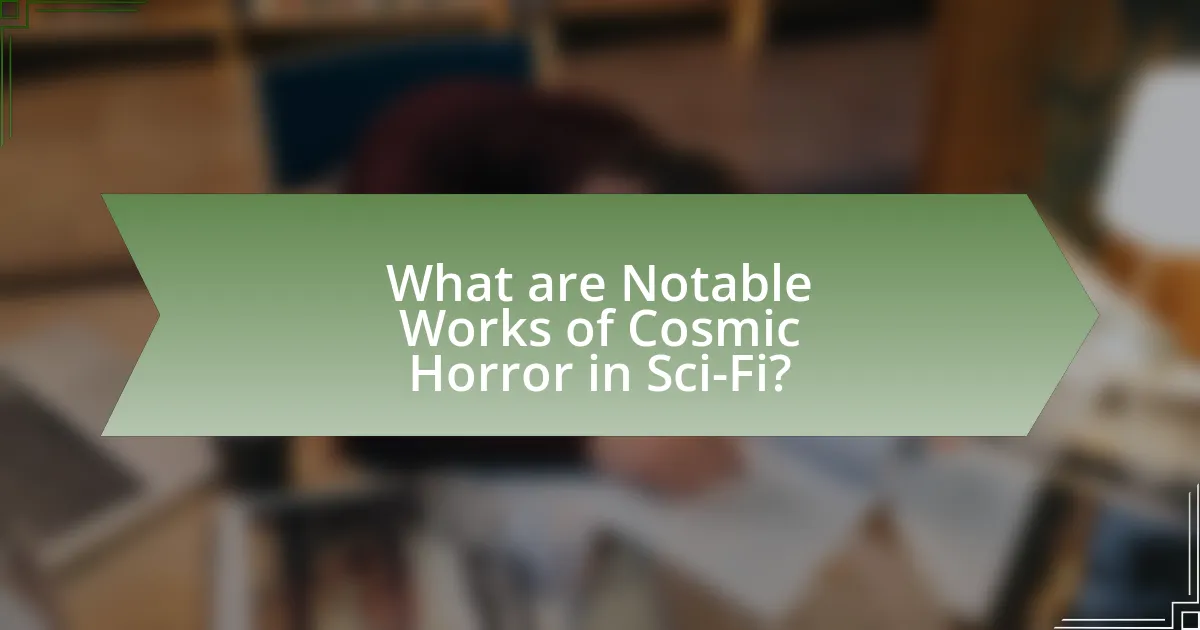
What are Notable Works of Cosmic Horror in Sci-Fi?
Notable works of cosmic horror in sci-fi include “The Call of Cthulhu” by H.P. Lovecraft, “Annihilation” by Jeff VanderMeer, and “The Fisherman” by John Langan. These works exemplify cosmic horror by exploring themes of existential dread, the insignificance of humanity in the universe, and encounters with incomprehensible entities. For instance, Lovecraft’s “The Call of Cthulhu” introduces an ancient cosmic being that challenges human understanding, while VanderMeer’s “Annihilation” delves into a mysterious area known as Area X, where the laws of nature seem to unravel. These narratives effectively illustrate the core tenets of cosmic horror, emphasizing the unknown and the terrifying vastness of the cosmos.
Which authors are most associated with Cosmic Horror themes?
H.P. Lovecraft is the author most associated with Cosmic Horror themes. Lovecraft’s works, such as “The Call of Cthulhu” and “At the Mountains of Madness,” explore the insignificance of humanity in the face of incomprehensible cosmic entities and the fragility of sanity. His influence on the genre is profound, establishing key elements like forbidden knowledge and the vastness of the universe that evoke existential dread. Other notable authors include Algernon Blackwood, whose story “The Willows” exemplifies cosmic terror, and Thomas Ligotti, who continues to expand on Lovecraftian themes in contemporary literature.
What are the defining features of H.P. Lovecraft’s works?
H.P. Lovecraft’s works are primarily defined by themes of cosmic horror, the insignificance of humanity, and the presence of ancient, incomprehensible entities. His narratives often explore the fragility of sanity when confronted with the unknown, emphasizing the limits of human understanding in the face of vast, indifferent cosmic forces. Lovecraft frequently employs a rich, archaic language and a sense of place, creating a unique atmosphere that enhances the eerie and unsettling nature of his stories. The Cthulhu Mythos, a shared universe of ancient gods and forbidden knowledge, serves as a foundational element in many of his works, illustrating the existential dread that permeates his fiction.
How have modern authors adapted Cosmic Horror for contemporary audiences?
Modern authors have adapted Cosmic Horror for contemporary audiences by integrating psychological themes, diverse characters, and modern societal anxieties into their narratives. This evolution reflects a shift from the traditional focus on existential dread and the unknown to exploring personal and cultural fears, such as technology’s impact on humanity and environmental concerns. For instance, authors like Caitlín R. Kiernan and Tananarive Due incorporate elements of identity and race, making the genre more relatable and relevant. Additionally, the use of advanced technology and contemporary settings allows for a fresh interpretation of Cosmic Horror, as seen in works like “Annihilation” by Jeff VanderMeer, which blends ecological themes with the traditional elements of the genre. These adaptations resonate with today’s readers, who face complex realities that echo the themes of Cosmic Horror.
What films and media effectively depict Cosmic Horror?
Films and media that effectively depict Cosmic Horror include “The Thing,” “Event Horizon,” and “Annihilation.” “The Thing,” directed by John Carpenter, showcases an alien entity that embodies the fear of the unknown and the loss of identity, which are central themes in Cosmic Horror. “Event Horizon,” directed by Paul W.S. Anderson, explores the psychological terror of a spaceship that brings back a malevolent force from another dimension, emphasizing the insignificance of humanity in the vastness of space. “Annihilation,” directed by Alex Garland, presents a mysterious phenomenon that alters reality and challenges the characters’ understanding of existence, reflecting the existential dread characteristic of Cosmic Horror. Each of these works illustrates the themes of incomprehensible entities and the fragility of human sanity in the face of the universe’s vastness.
How do visual elements enhance the Cosmic Horror experience?
Visual elements enhance the Cosmic Horror experience by creating an atmosphere of dread and the unknown, which is central to the genre. The use of unsettling imagery, such as vast, empty spaces and grotesque creatures, evokes feelings of insignificance and fear in the face of incomprehensible forces. For instance, films like “Event Horizon” utilize dark, claustrophobic settings and disturbing visuals to amplify the sense of existential terror. Additionally, the contrast between familiar environments and alien landscapes can heighten the viewer’s anxiety, as seen in H.P. Lovecraft’s works, where ordinary settings are transformed into nightmarish realms. This visual juxtaposition reinforces the themes of madness and the limits of human understanding, making the Cosmic Horror experience more immersive and impactful.
What are some examples of films that embody Cosmic Horror themes?
Some examples of films that embody Cosmic Horror themes include “The Thing,” “Event Horizon,” and “Annihilation.” “The Thing,” directed by John Carpenter, explores the terror of an alien entity that can imitate any life form, emphasizing themes of paranoia and the unknown. “Event Horizon,” directed by Paul W.S. Anderson, delves into the horrors of a spaceship that encounters a dimension of pure chaos, highlighting the fragility of sanity when faced with incomprehensible forces. “Annihilation,” directed by Alex Garland, presents a narrative where a mysterious phenomenon alters the laws of nature, leading to existential dread and the confrontation of the unknown. Each of these films illustrates the core elements of Cosmic Horror, where humanity’s insignificance in the universe is a central theme.
How can readers engage with Cosmic Horror in their own writing?
Readers can engage with Cosmic Horror in their own writing by incorporating themes of existential dread, the insignificance of humanity, and the unknown. This can be achieved by creating narratives that emphasize the vastness of the universe and the limitations of human understanding, often through the introduction of incomprehensible entities or forces. For instance, writers can draw inspiration from H.P. Lovecraft’s works, which frequently explore the fragility of sanity when confronted with cosmic truths. By utilizing atmospheric settings, unreliable narrators, and a sense of foreboding, authors can effectively evoke the unsettling nature of Cosmic Horror, reinforcing the idea that humanity is but a small part of a much larger, indifferent cosmos.
What techniques can writers use to create a sense of dread?
Writers can create a sense of dread by employing techniques such as foreshadowing, unreliable narrators, and the use of atmospheric settings. Foreshadowing builds anticipation and unease by hinting at future events, which can lead to a feeling of impending doom. Unreliable narrators distort reality, making readers question what is true, thereby increasing anxiety and tension. Atmospheric settings, particularly in cosmic horror, evoke feelings of isolation and insignificance in the vastness of space, enhancing the sense of dread. These techniques are effective because they manipulate readers’ emotions and perceptions, drawing them deeper into the unsettling themes of cosmic horror.
How can one effectively build tension in Cosmic Horror narratives?
To effectively build tension in Cosmic Horror narratives, one should emphasize the insignificance of humanity in the vastness of the universe. This can be achieved by introducing incomprehensible cosmic entities and presenting scenarios where human understanding fails, creating a sense of dread and helplessness. For instance, H.P. Lovecraft’s works often illustrate this through the depiction of ancient, powerful beings that exist beyond human perception, which instills fear and anxiety in characters and readers alike. The use of unreliable narrators can further enhance this tension, as their distorted perceptions of reality contribute to an atmosphere of uncertainty and paranoia.
